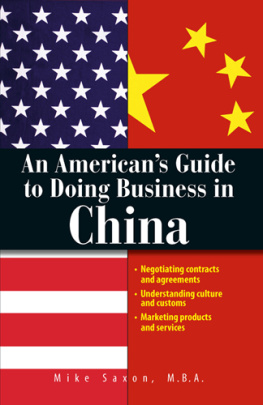
An American's Guide to doing Business in China
Negotiating contracts and agreements Understanding culture and customs Marketing products and services
Mike Saxon, M.B.A.

Copyright 2007, Mike Saxon. All rights reserved. This book, or parts thereof, may not be reproduced in any form without permission from the publisher; exceptions are made for brief excerpts used in published reviews.
Published by Adams Media, an F+W Publications Company 57 Littlefield Street, Avon, MA 02322. U.S.A. www.adamsmedia.com
ISBN 10: 1-59337-730-4
ISBN 13: 978-1-59337-730-4
ISBN-13: 978-1-60550-849-8 (EPUB)
Printed in the United States of America.
J I H G F E D C B A
Library of Congress Cataloging-in-Publication Data
Saxon, Mike.
An American's guide to doing business in China / Mike Saxon.
p. cm.
ISBN-13: 978-1-59337-730-4
ISBN-10: 1-59337-730-4
1. International business enterprises China. 2. Investments, Foreign China. 3. China Commerce. I. Title.
HD2910.S39 2007
330.951 dc22
2006028140
This publication is designed to provide accurate and authoritative information with regard to the subject matter covered. It is sold with the understanding that the publisher is not engaged in rendering legal, accounting, or other professional advice. If legal advice or other expert assistance is required, the services of a competent professional person should be sought.
From a Declaration of Principles jointly adopted by a Committee of the American Bar Association and a Committee of Publishers and Associations
Many of the designations used by manufacturers and sellers to distinguish their product are claimed as trademarks. Where those designations appear in this book and Adams Media was aware of a trademark claim, the designations have been printed with initial capital letters.
This book is available at quantity discounts for bulk purchases. For information, please call 1-800-289-0963.
INTRODUCTION
M UCH HAS BEEN WRITTEN about China lately, hyping the business opportunities now available in that country. The truth is that there really are many great opportunities there. In order to take advantage of them, though, you will first need to run a gauntlet of obstacles, ones for which you may be unprepared. My goal in this book is to prepare you for the challenges that await you and to offer specific advice that will allow you to seize those opportunities, while avoiding the pitfalls. Most of the material here comes from my own direct experience, and that of my company, China Business Partners ( www.chinabusinesspartners.com ).
One source of information on China that I would like to specifically recognize for its excellent research and statistics-gathering is the Wall Street Journal. The WSJ has printed many a story about different aspects of life in China that have informed the discussion here, and I recommend it as one of the best sources for keeping up to date on changes in China.
In recent years, Americans have been overly enthusiastic about China. Encouraged by a government eager for foreign capital and technology, and entranced by the prospect of 1.3 billion consumers, thousands of American and other foreign firms have rushed into the Chinese market without fully investigating the market situation, performing the necessary risk assessment, or getting expert advice. Without the necessary preparation, these companies and individuals often enter into bad business deals. The result is lost time, lost opportunity, and lost money.
The odds that any new business venture will succeed in China are far worse than the odds you would face in the United States. You will be in a strange environment, with inadequate communication skills, few places to find help, and without key contacts or friends.
You may have heard many stories of business people succeeding in China. Many Americans have succeeded there, to be sure, but many more have failed and very few have succeeded on their first try.
Whatever you want to do in China buy or sell something, have something made, find a partner, open a business, invest money, or anything else the basic rule to know is this: Reaching an acceptable agreement to do anything is not the end. Murphy's laws, in all their forms, definitely apply here. It will take far longer to achieve your goal than you think, and it will take far more effort, time, money, and attention than you are planning. Don't assume that anything will happen unless you pull it through.
You must check on progress constantly and personally until you reach your goals. Then you must put fail-safe systems in place that assure continued performance up to the standards you have set.
While reform is absolutely essential for China to fully participate in the world trading community, in many areas these changes have not yet taken place. Companies must deal with the current environment in a realistic manner. Risk must be clearly evaluated. If a company determines that the risk is too great, it should seek other opportunities.
China has undergone an incredible transformation from a hostile, secretive, and insular country to a seemingly friendly and open one that welcomes you (and your money), and will, in many cases, grant you favors.
China's outward attitude change has resulted in accession to the World Trade Organization (WTO), a change that brings many new opportunities. Some have described it as the beginning of time for trade relations, because of the plethora of changes that China has already made and has agreed to make in the future in its laws, rules, regulations, and attitudes regarding foreign investment and trade. Problems will not disappear overnight, but instead of the traditional protectionism, free trade is the order of the day.
How to Use This Book
Within An American's Guide to Doing Business in China, how-to advice is given freely if it might show you a path to success that you may not be aware of. Sometimes you will learn of possible scenarios without being offered a specific course of action. When specific actions to take are suggested, realize that those recommendations are based on years of experience with American and Chinese firms doing business, from both sides of the fence and in the middle. I've seen what works and what doesn't, and I've set out to arm you for the travails ahead.
The book is organized so that you may read some sections without having to read other application sections that may not interest you. Some general sections (basically, Part One and Part Two and much of Part Three) should be pertinent to many applications, and everyone who is interested in doing business in China should read them. Other sections of Part Three, as well as Part Four, may be of interest depending on the type of business you are involved in.
Part One starts with points of common interest about China, including China's evolving role in the world, general issues an American faces in being there, and some background, perspectives, and trends on political, economic, and legal issues (including some forecasting as to where current trends will lead).
Next up, Part Two discusses other topics of importance to anyone doing business in China, such as the problems of dealing with the language barrier (Chapter 3), important and unique cultural issues (Chapter 4), and a detailed coverage of Chinese customs and how they will impact you (Chapter 5). The last three chapters of Part Two cover financial, legal, and import/export issues, along with the very important subject of what you need to know before embarking on a trip to China.









